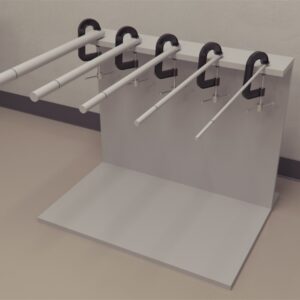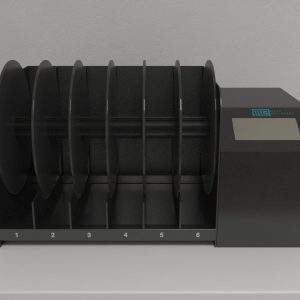$4,990.00 – $5,490.00Price range: $4,990.00 through $5,490.00
The General Rodent Activity System is an automated tool designed for monitoring, recording, and analyzing the locomotor and behavioral activity of rodents. This system features an open field box encircled by an outer area divided into quadrants, with activity integration that tracks the animal’s location. It is a modified version of the Open Field arena and Hole Board apparatus, equipped with sensors for behavior recording and software for comprehensive analysis.
This system can evaluate various behaviors related to anxiety, exploration, thigmotaxis, and both working and reference memory. It is suitable for assessing the impact of age on locomotion, investigating neuromuscular abnormalities in genetically modified animals, and evaluating the effects of therapeutic interventions on movement and behavior.
Additionally, the system incorporates the Activity Hole Board.

MazeEngineers empowers preclinical neuroscience research with meticulously designed, customizable behavioral apparatuses. From manual classic mazes to fully automated smart systems, we provide the tools scientists need to capture high-quality, reproducible data for studies on learning, memory, anxiety, and depression.

bool(false)

bool(false)

Mouse |
40 x 40 x 30 cm (L x W x H) |
16 holes; 2cm diameter |
Rat |
60 x 60 x 40 cm (L x W x H) |
16 holes; 3cm diameter |
Real-time location measurements are recorded throughout the given experiment time. Adjustable sensors report location data using X and Y coordinates. X and Y coordinates can be scaled to the Activity system's physical dimensions (40 x 40 cm for mice and 60 x 60 cm for rats) for real-time location measurements.
Tracked paths in real-time and throughout the experiment. A visualization of the path made by the animal subject is observed within the software under activity data using X and Y coordinates (see the image below ).
Users can choose a time interval post experiment and draw an activity chart indicating the location, number, and timing of jumps as time, and count points. For example, (10,4) indicates 4 jumps within 10 seconds. The following results are recorded: When a jump occurs When the animal moves without a jump When the animal moves while in the jump position Number of times the animal jumped during a given duration
Number of nose pokes, locations, sequence of, and time taken for a head dip are recorded. Time stamps in milliseconds record which hole a head dip begins and when it ends to create head dip duration. The following activities are recorded: The location of the hole in which the subject dipped its head The sequence of head dips Duration of the head dip

The Activity System is an automated platform designed for observing, recording, and analyzing the locomotor and behavioral activity of rodents. This system is a modified version of the Open Field arena and Hole Board apparatus, and it comes with specialized software for behavior analysis. It can track the animal’s location and differentiate between movements made with a jump and those without. Additionally, experimenters can set specific time intervals to record the number of jumps, which is displayed in a “Jump Chart.” The software also visually represents the animal’s locomotion throughout each trial.
The open-field arena is commonly utilized to evaluate rodents’ locomotion, exploratory behavior, and anxiety levels. The Hole Board apparatus not only assesses exploratory behaviors but also evaluates working and reference memory. By integrating both of these apparatuses, the Activity System simplifies the process of measuring and analyzing rodent behavior, eliminating the need for manual observation and recording. The floor of the system features holes equipped with sensors to log which hole the subject investigates and the duration of each nose poke.
This system serves as an effective in vivo locomotion assay for a variety of experiments. It can be employed to examine how age influences locomotion behavior, investigate neuromuscular abnormalities in genetically modified animals, assess anxiety-related behaviors, evaluate the impact of neurodegenerative diseases on memory, and analyze the effects of therapeutic interventions on locomotion and behavior.
The Activity System features an open field arena designed for both rats and mice, with distinct measurements for each species. The dimensions for rats are 60 × 60 × 40 cm (L × W × H), while for mice, it measures 40 × 40 × 30 cm. The arena’s floor is equipped with 16 evenly spaced holes, with each hole having a diameter of 3 cm for rats and 2 cm for mice. The height of the sensors within each hole can be adjusted as needed. The walls of the arena are constructed from plexiglass.
Additionally, the system includes software that tracks and records the animal’s location, providing a visual representation of the activity data collected.
Installation of the software is simple and easy with standard download and installation steps.
The Activity box can easily be connected to your computer using a standard USB cable. Connection occurs once your PC has recognised the apparatus.
The user interface is easy to use with configurable parameters.
Results summaries report the animal's location, visualise their path throughout the experiment, jumps, time intervals, nose pokes, and more!
Maze Engineers / ConductScience support and troubleshooting is provided throughout your experiment and set-up.
Zhang, Li, and Han (2020) conducted an analysis of mouse locomotor activity utilizing an activity system that included an open field, a webcam, and a computer equipped with specialized software. The system effectively measured key metrics such as distance traveled, velocity, and thigmotaxis in the animals.
In a separate study, Aragão et al. (2011) investigated locomotor activity in rodents using an automated activity system featuring an open field with 30 cm high walls. This system employed digital images captured under infrared light to monitor the movements of freely roaming rodents. The recorded videos were subsequently analyzed using dedicated software. The study focused on fifteen male Wistar rats, documenting various metrics, including distance traveled, average speed, average acceleration, time spent immobile, number of stops, and duration spent in specific areas within the apparatus. The animals were assessed on multiple postnatal days to evaluate the reproducibility of the findings. Results demonstrated that the system effectively captured all parameters, revealing developmental changes in the movement patterns of the subjects over time.
Aragão, R., Rodrigues, M. A., de Barros, K. M., Silva, S. R., Toscano, A. E., de Souza, R. E., & Manhães-de-Castro, R. (2011). Automatic system for analysis of locomotor activity in rodents–a reproducibility study. Journal of neuroscience methods, 195(2), 216–221. https://doi.org/10.1016/j.jneumeth.2010.12.016
Zhang, C., Li, H., & Han, R. (2020). An open-source video tracking system for mouse locomotor activity analysis. BMC research notes, 13(1), 48. https://doi.org/10.1186/s13104-020-4916-6
| Species | Mouse, Rat |
|---|
There are no questions yet. Be the first to ask a question about this product.